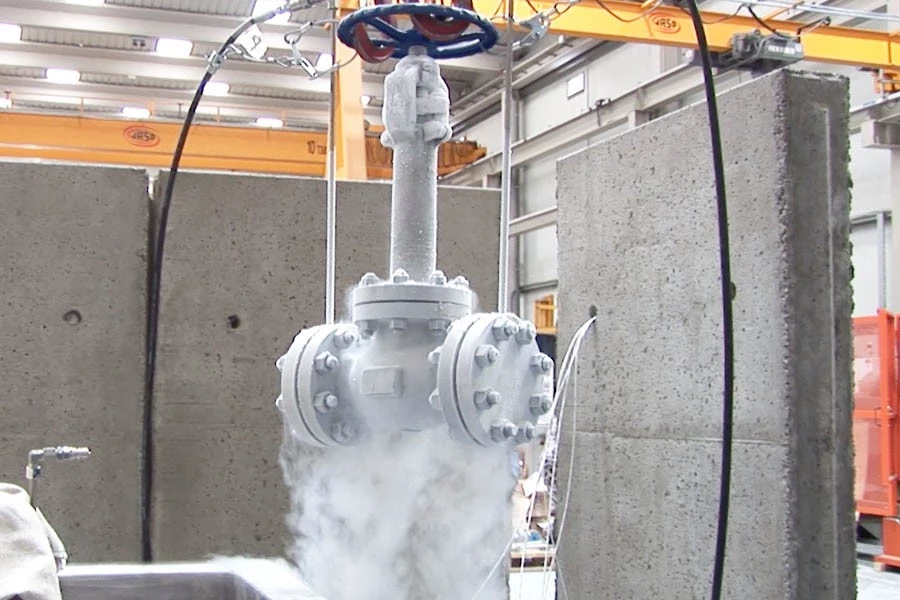Since cryogenic valves can operate effectively at temperatures as low as -196°C (-320°F) and pressures as high as 52 bar (750 psi), they are designed to store these gases safely and perform admirably during transportation.
Working Cryogenic Valves
To ensure the safety and security of cryogenic gasses or other media, cryogenic valves are maintained in their naturally closed position. In general, a cryogenic valve is made to respond to high pressure by pushing itself into the open position, which permits easy passage of gas or other media. This open flow will continue until the pressure drops once more, at which time it will swing back and seal, preventing any leaks with a unique metal seat bubble-tight shutoff.
What makes other valves inappropriate?
Particularly sensitive media include cryogenic gases. Given how expensive it is to convert standard temperature gases into cryogen, having it leak in an unintended location can result in significant and expensive damages.
Because standard valves expand and contract at different rates in hot and freezing temperatures, they are susceptible to extreme temperatures. This can lead to seal breaks and undesirable leakage. These heat gains have long been a source of concern for those studying, transporting, and storing cryogenic gas processing.
Why is the bonnet of a cryogenic valve extended?
Combustible and explosive liquid media that the cryogenic valve transfers include ethylene, liquid oxygen, liquid hydrogen, liquefied natural gas, liquefied petroleum, and other liquid media. Furthermore, when the temperature rises, they will gasify and expand hundreds of times.
An extended bonnet, or more specifically, an extended stem, is a standard feature of this type of valve. This is due to:
1.The stuffing box, which is crucial to the cryogenic valve and other valves, can be shielded from the damaging effects of low temperature by the extended bonnet.
The packing will progressively lose its elasticity and its ability to stop leaks as the temperature drops. Next, the medium freezes in the gap between the packing and the stem, making it difficult for the stem to move and causing the packing to get scratched. Finally, there is severe leakage that happens.
In order to guarantee that the packing is sufficiently warm—at least above 8°C—an extended stem is used.
2.It is convenient to wrap special materials around the valve to stop the loss of cold energy because of the extended structure of the bonnet.
3.Although the pipes and valves are frequently placed inside the so-called "cold box," the "long neck" of the pipe can pass through the wall of the box. Based on this, the extended stem facilitates a quick and easy removal or replacement of the valve's main components through the bonnet.
Therefore, to guarantee the valve's sealing performance and minimize cold box leakage, the valve body and pipeline are welded together.
Types of cryogenic valves and their variations
Cryogenic valves that are appropriate for use at a range of pressures are now available in a variety of sizes and shapes. Ball, butterfly, gate, globe, check, and relief valves are a few of the most widely used types. They can also be automated or manual, which is essential in complex systems.
Cryogenic butterfly valves: The circular disc in the middle of cryogenic butterfly valves gives them a shorter length. They are employed in systems that require quick opening and closing actions because they are lightweight, affordable, and easy to use.
Cryogenic gate valves: The wedge-shaped gate of a cryogenic gate valve closes in line with the body mounting. This means that even when it is fully open, there is very little pressure drop.
Cryogenic globe valves The spherical form of cryogenic globe valves is complemented by an internal rotating disc that spins at a right angle to the plane of the body mounting. They offer long-term sealing that is effective in this way. It is not advised to use them in high flow systems, though.
Cryogenic relief valves: When safety limits are exceeded, cryogenic relief valves allow steam to escape while providing protection against overpressure above a predetermined value. Similar to this, cryogenic check valves keep fluids from flowing back while maintaining pressure.

